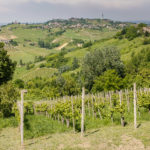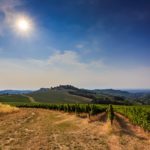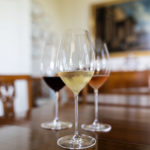OLTREPÒ PAVESE – peaceful landscapes and Pinot Nero perfection
This beautiful and refreshingly under-explored corner of southern Lombardy is a joy to discover for its hilly landscapes covered in vines and woodland and its many historic wineries, each with a story to tell and wonderful wines to enjoy.

WHERE IS OLTREPÒ PAVESE?
The Oltrepò Pavese area is just 60km from Milan (about an hour by car) and close to the attractive historic city of Pavia, famous for its statuesque Certosa monastery complex. The area, which shares borders with Piedmont, Liguria and Emilia Romagna and shows influences from all three, is Italy’s top production zone for Pinot Nero, one of the world’s favourite and most famously delicate grape vines. The variety has found an ideal home here in Oltrepò Pavese’s hilly terrains, producing excellent red wines and exceptional Traditional Method spumante, considered by many to be among Italy’s best sparkling wines. Oltrepò Pavese wineries are diverse, with small family-run estates standing alongside an astonishing range of producers with striking historic locations including former monasteries, castles and noble villas. Although Pinot Nero was first planted in Oltrepò Pavese around 150 years ago, winemaking has been established here for much longer. The first documented mention was in fact by Greek writer Strabo in 60BC and an ancient fossilised vine shoot found near the town of Casteggio is proof that grapes already grew here in prehistoric times. There is a lot more to the local wine scene of course than just Pinot Nero – other wines to try include some intriguing Riesling and, to the eastern part of the area, intense and complex red Buttafuoco wines made from the traditional blend of Barbera, Croatina and local varieties Uva Rara and Ughetta.
OLTREPÒ PAVESE – THE WINE AREAS
While the fact that the shape of the Oltrepò Pavese area is reminiscent of a bunch of grapes is a cute coincidence, the key to the quality of the local wines lies in the combination of different soils (that range from marly and clay-based to sandy and even chalky), good ventilation and extreme day to night temperature swings on often steeply sloping hillsides. The 45th parallel, known as ‘the wine parallel’ as it joins the dots between some of the world’s leading wine zones, runs through the area, which stretches southwards from the plains of the north through a series of valleys and continuously rising hills, reaching heights of as much as 1700m asl, although currently vines are grown up to around 600m asl.

The valleys of Oltrepò Pavese from east to west:
Valle Versa, a cool area ideal for maintaining the fresh acidity that makes for excellent sparkling wines.
Valle Scuropasso, leading from Broni, one of the area’s main centres and home to the Enoteca Regionale wine bar and store, up through wooded hillsides.
Valle Coppa, leading from Casteggio, an important wine centre since ancient times with the area’s greatest concentration of leading wineries.
Valle Staffora, to the west of the area and also well known for its delicious cheeses, the valley stretches into the hills at Varzi, home to a celebrated salami.
OLTREPÒ PAVESE – WINES & VINES
A few of Oltrepò Pavese’s most representative wines.

THE WHITES AND ROSÉS
Oltrepò Pavese Metodo Classico DOCG
The star wines of the area are undoubtedly the Traditional Method sparklers, Oltrepò Pavese’s only category to have prestigious DOCG recognition. While current regulations require these white and rosé spumante wines to be made with Pinot Nero for at least 70% (or 85% if Pinot Nero is included in the name) with Chardonnay, Pinot Bianco or Pinot Grigio permitted for the remaining percentage, many wineries opt for 100% Pinot Nero. The second fermentation takes place in the bottle following the Traditional Method and the wines must rest on the lees for at least 15 months (24 months for vintage spumante). The resulting wines are impressive – characterful sparklers with good structure and fresh, savoury taste profiles. Most producers’ top of the range wines are zero dosage versions which bring out the best of the singing acidity.
Oltrepò Pavese DOC Riesling
Of the numerous varietal wines coming under the umbrella of the Oltrepò Pavese DOC denomination, Riesling is the stand-out favourite among producers and wine lovers alike. The area is a leader for Riesling production in Italy and sparkling and semi-sparkling versions are made as well as deliciously persuasive still wines and Riservas. While regulations allow for both Riesling Italico and Riesling Renano, more and more wineries are opting for the latter for its greater aromatic depth and age-worthiness.
THE REDS
Pinot Nero dell’Oltrepò Pavese DOC
This is the denomination for red Pinot Nero wines, also Riserva versions which are aged for at least 24 months with at least six months in wooden barrels. Styles vary greatly, thanks to terroir and methods, but the majority of wines are rich and persistent, fresh, herby and rewarding.
Buttafuoco dell’Oltrepò Pavese DOC
These intense and complex wines, made with a traditional red blend of native variety Croatina and Barbera, along with optional additions of local varieties Uva Rara and Ughetta, are ideal with the area’s typical ravioli al brasato (pasta filled with braised beef).
The classic area lies in the hills between the Versa and Scuropasso valleys and the best place to get to know the wines is at the Casa del Buttafuoco Storico run by the local producers’ association, where you can taste a selection of wines, relax over a meal or simply enjoy a glass. Try too the sweet version of the same kind of blend: Sangue di Giuda DOC.
Bonarda dell’Oltrepò Pavese DOC
Not to be confused with Piedmont’s Bonarda grape, these wines are made with at least 85% of the native variety officially known as Croatina which is often used in blends or for semi-sparkling wines that make a classic pairing with the tasty local salami di Varzi. Richly fruity and smooth still versions of Croatina are well worth seeking out.
OLTREPÒ PAVESE – QUICK FACTS

13,500 ha under vine (over 11,000 ha dedicated to DOC and DOCG wines)
3,000 ha of Pinot Nero vines (Italy’s largest area of Pinot Nero)
Other main varieties: Croatina, Barbera, Riesling
1700 wine producers
Altitudes from 0m to 1700m asl; vines up to 600m asl